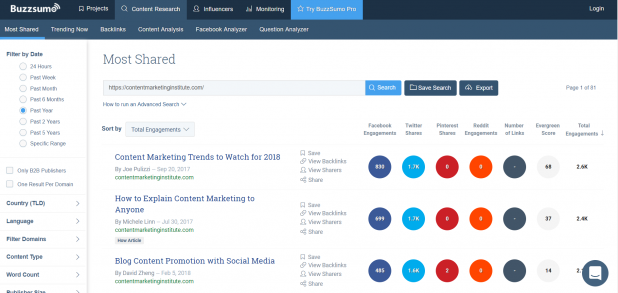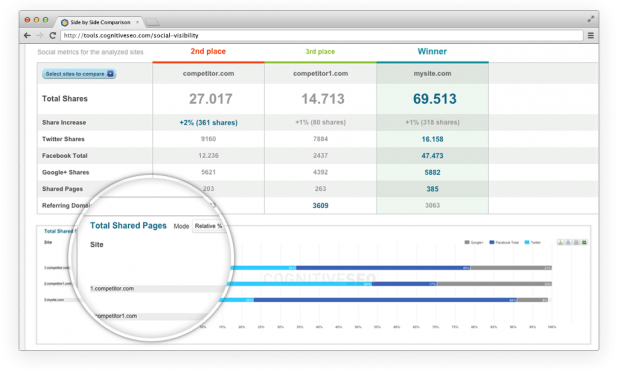To run a successful business, part of the challenge is making sure your marketing campaigns are doing better than your competitors.
While there are many ways to do this, one method takes the lead in providing the most accurate and actionable data: competition analysis.
With proper competition analysis, you can get insight on the following:
- Differences in the products and services offered
- Newer and more effective lead acquisition strategies
- Sales techniques for closing leads
- Market structure used to increase reach
- Efficacy of key distribution channels
Even if you have an entire marketing tool set at your disposal, if you don’t have data about your competition, you could end up running in circles.
For content marketers, getting actionable data is a key step to finding gaps in the strategies of competitors while making sure you don’t have these gaps in your own.
And here’s how you can do that:
1. Audit What Your Competitors Have
One of the best ways to uncover your competitor’s content marketing approach is to find out exactly what they have right now.
This information is crucial so you get an idea of what it is you’re dealing with and what you have to outperform.
Below are examples of questions that can guide you in auditing your competitors:
- What types of content are they publishing?
- What is their publishing frequency?
- Which has the greatest impact?
- How are they promoting them?
With the first question, you’ll need to know how many infographics, case studies, ebooks, or videos they’re producing. Find out which type of content they’re publishing the most of, and make sure to have all of that information organized, i.e. in a spreadsheet.
For the second question, get information on how many times they publish a certain type of content. One effective approach is to measure by weekly publishings: i.e. three times a week.
And for the third question, you’ll need to find out which of their posts are garnering the most attention and social media shares. One great tool that can help you do that is BuzzSumo:

As you can see from the image above, you already have your fourth question answered, as well. This is why BuzzSumo is a hit with businesses that want to know their own content marketing performance and that of their competitors. It shows you a lot.
Come Up With More Questions
Your data needs will vary depending on the unique goals of your marketing campaign. So, come up with as many questions until you feel your competition analysis covers everything you need.
Keep an eye out for possible gaps in their content performance, as well. This can help you get a clearer picture of how your own brand can outshine them. For example, if you find that your website pages load slower than your competitor’s site, you can try a reliable content delivery network to boost your pages’ loading time.
2. Evaluate The Quality of Their Content
This next step involves taking a look at both what’s hot and what’s not. But take note that content evaluation is a subjective process; it isn’t all just black and white.
One good approach is to start with their most popular content, which you should already know if you’ve taken the steps above. Dissect their content and find out what makes them interesting.
Look For The Best and Worst
Always keep in mind that competition analysis is about having an eye for quality and a mind for criticism. Even if you have the best possible content in front of you, you can still find something about it that can be polished if you look hard enough.
After you’re done taking a look at their great content, the next step is to scout for their worst. There’s plenty you can learn from this batch, so make sure to have your spreadsheet ready.
You’ll notice that some of the content may have been well-made, but they didn’t do too good a job marketing it. You don’t want this happening to your own content, so make a note of it.
Above is an example of how you can organize the data from your competitive analysis so far. But don’t feel that you need to stick this format. Play around with it and add more categories as you see fit. In a lot of cases, the more detailed your analysis, the better you can identify key factors to use for creating or adjusting your own content marketing strategy.
3. Micro-Analyze
Now that you know which types of content your competitor produces, it’s time to put them under the lens. Take a couple of sample pieces from each type of content they have. You could choose two blog posts, two PDFs, or two newsletters.
Next, get to know the different parts of the content and analyze how they create or structure them. Oftentimes, companies follow a basic procedure for crafting their blog posts or emails.
The below image is an example of information you can get from analyzing blog posts:
Analysis: Competitor 1 – Blog Posts
- Mostly list-types always exceeding 5 items
- Always contains 3-5 pictures per 1,000 words
- CTA in the first and last paragraph
- Titles always include number(s)
- Personalized featured images containing title of blog post
4. Do a Side-by-Side Comparison
Competitive analysis is all about spotting the strengths, weaknesses, and areas of opportunity for your business in relation to a competing business’ marketing model.
While there are numerous approaches you could take to achieve the above effect, a very straightforward one would be to do a side-by-side comparison, or a comparative analysis.
One tool that does this surprisingly well is CognitiveSEO’s Content Visibility module:

From their platform, you gain tracking capability on the social footprint of different competitors, as well as your own. Whether it’s Twitter, Facebook, Instagram or Google Plus, they do a great job of analyzing what’s happening on the content sharing side.
This is a step up from just normal competitive analysis, because you’re doing it while placing attention on your own strategies. And it can be a great way to give your business that competitive advantage.
See Every Competition As An Opportunity
We’ve all heard that no one gets better in a vacuum. But you also can’t make significant progress if you don’t know how your business stacks up against the competition.
This is why content marketers must include competitive analysis in their strategy if they’re ever to stand out from the thousands of other run-of-the-mill brands out there.
With the right tools and information, you can produce marvelous results from your content marketing efforts. Especially after you do find out where you can gain a competitive advantage against other businesses in the same niche.






